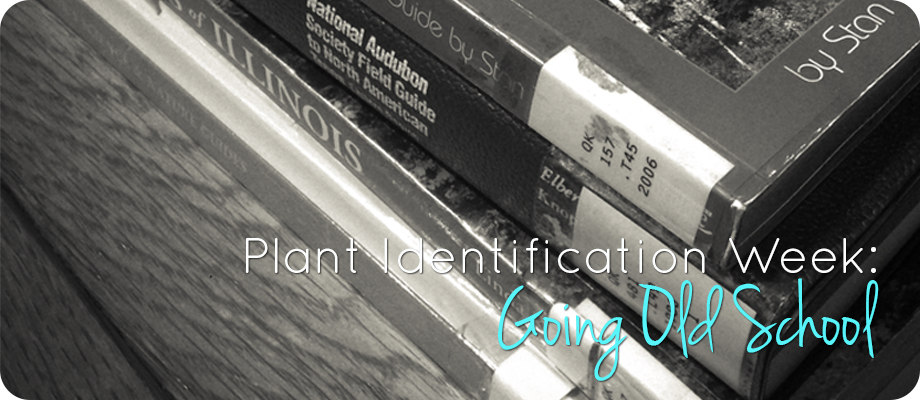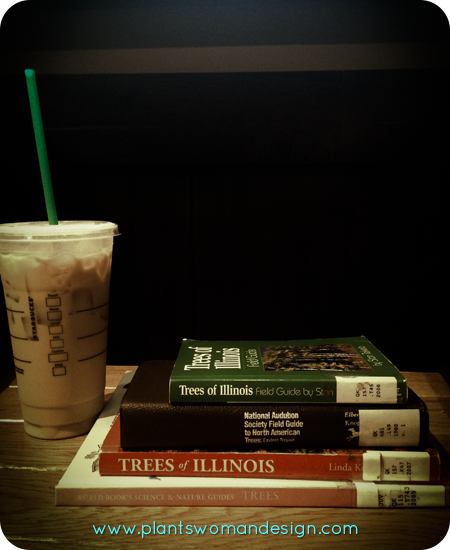Welcome back and happy Independence Day! This week we’ve been talking about how to identify the trees and plants around your home/property/neighborhood. On Wednesday we talked about some free mobile apps, if you missed that post you can read it HERE, and today we are talking about books. Yep, good old fashioned ink-on-paper-feel-the-binding-turn-the-pages books. After being slightly disappointed with the apps I tested out, except for Garden Compass, I started to wonder if I was going about this all wrong. Just because there is an app available doesn’t seem to mean it’s the best tool for the job. With that in mind I headed to my local library to see what I could find.
I’ll admit the last couple times I’ve walked into a public library I’ve been a little stumped as to where to start. This time I went straight to the reference desk and asked for help. The lovely lady there asked me what I was looking for. I told her I was looking for books to help me identify the trees in our neighborhood. She then asked me if I was working with kids or not and I said yes to both, just to see what she would come up with, and away we went. She took me to several different places around the library and left me in the garden section to make my selections. As you can see from the photo I’m in Illinois so I picked up books specific to this state. Your local library will likely have resources specific to your area. I didn’t really have a rhyme or reason for picking the books I came home with. I just took a quick flip through the book to see if it seemed helpful then decided. The Audubon book is the only book I immediately picked up with out looking through it based on the Audubon’s reputation.
After leaving the library I headed to a coffee shop near by to take a look at what I’d found. Using the photos I had submitted to Garden Compass I tried to identify the plants I had found.
Here’s what I ended up with…
National Audubon Society Field Guide to North American Trees: Eastern Region I started with this guide once I had a lovely iced beverage in my hand. After leafing through it a bit I went back to the beginning “how to use this guide” section and continued on from there. I was able to identify the Linden tree (or American Basswood) fairly quickly but got stuck when it felt like the variety I had in my neighborhood was more akin to the Carolina Basswood, which is not found in my area, than the American Basswood, which is found in my area. To cross reference I moved onto the guides specific to my area.
Trees of Illinois by Stan Tekiela To help me identify the Linden tree more accurately I started with this guide. Again, I took a look at the “how-to” section and then dove in. One of the features I enjoyed in this guide was the use of icons on the corners of the pages to help you identify your specimen more efficiently. I also took a look at Trees of Illinois by Kinda Kershaw. Both guides had great information and each included their own sometimes anecdotal information which made for an interesting read.
Had I been familiar with the way guide books were set up I may have had slightly better luck with the apps I tried as they have some of the same structural pieces woven into them.
Science & Nature Guides Trees was a book the librarian pulled for me for working with kids. The book itself covers trees from the United States and Canada. What I found great about it were the activities that were included. Such as how to measure the height of a tree, how to figure out the age of a tree (with out cutting it down to count the rings of course) and tips on collecting leaves. I will be pulling some activities from this book to do with my kids. I’ll post our results and printables tomorrow here on the blog.
After all is said and done there is something to be said about reaching for a book instead of a computer to find the information you need. Feeling the heft of the book in your hand, catching the slight scent of the pages as you turn them, slowly mulling over the words on each page… It’s slow and unhurried. I am grateful for the speed at which I can get the information I need with out much fuss. I love being able to follow my friends and family on Facebook and see what they are up to on Instagram but lately I see that there is an increasing need in myself to stop and look up. To slow down and not expect instant access to the entire world at a moments notice. To engage in my community. To be present with my family. Maybe it’s just a mental thing but picking up a book instead of a computer, not matter how small, feels like permission to slow down and I’ll take it.
Sifting through the field guides was an enjoyable venture and I’m now eager to share what I’ve found with my kids. Did I find an old school answer to an old school problem? Yes, I think I did. And while it’s great to have an app like Garden Compass in my back pocket for when I get truly stumped I’m so pleased to know how to navigate through a field guide and will be adding some of these books to our home library soon.
Check back tomorrow to see our books in action!



